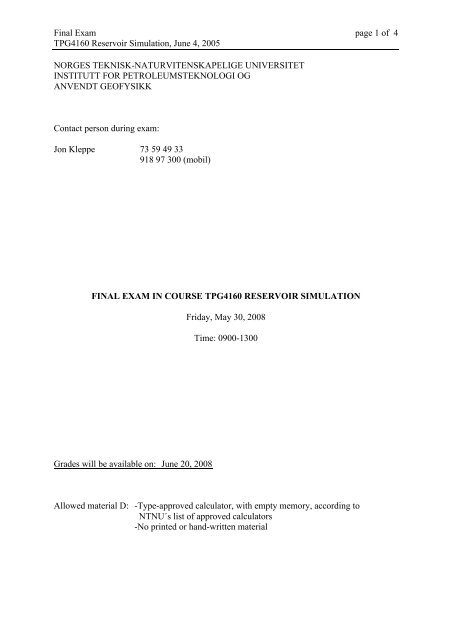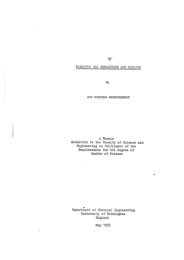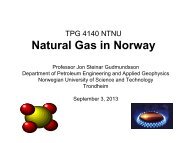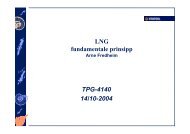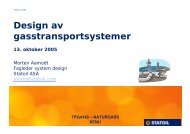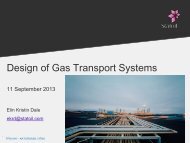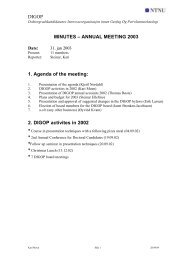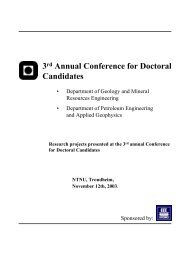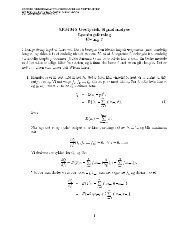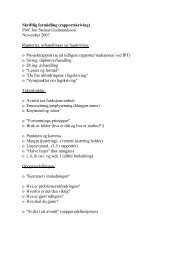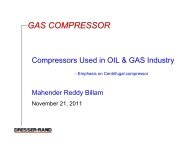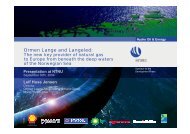Final Exam TPG4160 Reservoir Simulation, June 4, 2005 page 1 of ...
Final Exam TPG4160 Reservoir Simulation, June 4, 2005 page 1 of ...
Final Exam TPG4160 Reservoir Simulation, June 4, 2005 page 1 of ...
Create successful ePaper yourself
Turn your PDF publications into a flip-book with our unique Google optimized e-Paper software.
<strong>Final</strong> <strong>Exam</strong><br />
<strong>TPG4160</strong> <strong>Reservoir</strong> <strong>Simulation</strong>, <strong>June</strong> 4, <strong>2005</strong><br />
<strong>page</strong> 1 <strong>of</strong> 4<br />
NORGES TEKNISK-NATURVITENSKAPELIGE UNIVERSITET<br />
INSTITUTT FOR PETROLEUMSTEKNOLOGI OG<br />
ANVENDT GEOFYSIKK<br />
Contact person during exam:<br />
Jon Kleppe 73 59 49 33<br />
918 97 300 (mobil)<br />
FINAL EXAM IN COURSE <strong>TPG4160</strong> RESERVOIR SIMULATION<br />
Friday, May 30, 2008<br />
Time: 0900-1300<br />
Grades will be available on: <strong>June</strong> 20, 2008<br />
Allowed material D: -Type-approved calculator, with empty memory, according to<br />
NTNU´s list <strong>of</strong> approved calculators<br />
-No printed or hand-written material
<strong>Final</strong> <strong>Exam</strong><br />
<strong>TPG4160</strong> <strong>Reservoir</strong> <strong>Simulation</strong>, <strong>June</strong> 4, <strong>2005</strong><br />
<strong>page</strong> 2 <strong>of</strong> 4<br />
Question 1 (27 points)<br />
Explain briefly the following terms as applied to reservoir simulation (short sentence and/or a<br />
formula for each):<br />
a) Control volume<br />
b) Mass balance<br />
c) Taylor series<br />
d) Numerical dispersion<br />
e) Explicit<br />
f) Implicit<br />
g) Stability<br />
h) Upstream weighting<br />
i) Variable bubble point<br />
j) Harmonic average<br />
k) Transmissibility<br />
l) Storage coefficient<br />
m) Coefficient matrix<br />
n) IMPES<br />
o) Fully implicit<br />
p) Cross section<br />
q) Coning<br />
r) PI<br />
s) Stone´s relative permeability models<br />
t) Discretization<br />
u) History matching<br />
v) Prediction<br />
w) Black Oil<br />
x) Compositional<br />
y) Dual porosity<br />
z) Dual permeability<br />
Question 2 (22 points)<br />
For a completely water-wet system, make sketches <strong>of</strong> saturation functions (including labels<br />
for important points/areas)<br />
a) Oil-water system: imbibition and drainage k rw<br />
, k row<br />
, P cow<br />
vs. S w<br />
b) Oil-gas system: imbibition and drainage k rg<br />
, k rog<br />
, P cog<br />
vs. S g<br />
c) Typical contours <strong>of</strong> three-phase k ro<br />
in a ternary (triangular) diagram (axes S o<br />
, S w<br />
, S g<br />
)<br />
Then, answer the following questions:<br />
d) Make sketches <strong>of</strong> Black Oil fluid properties B<br />
o, Bg<br />
, Bw,<br />
Rso,<br />
µ<br />
o,<br />
µ<br />
g<br />
, µ<br />
w<br />
. Label bubble<br />
point pressure, and saturated and undersaturated regions.<br />
e) Write expressions for reservoir densities for the three fluids (oil, gas, water) in terms <strong>of</strong><br />
B , B , B , R , ! , ! , ! .<br />
o<br />
g<br />
w<br />
so<br />
oS<br />
gS<br />
wS<br />
f) Write the expression for the density <strong>of</strong> the part <strong>of</strong> the reservoir oil that remains liquid at the<br />
surface.<br />
g) Write the expression for the density <strong>of</strong> the part <strong>of</strong> the reservoir oil that becomes gas at the<br />
surface.<br />
h) Derive an expression for the gas density based on the real gas equation.<br />
i) Write the definition for fluid compressibility.
<strong>Final</strong> <strong>Exam</strong><br />
<strong>TPG4160</strong> <strong>Reservoir</strong> <strong>Simulation</strong>, <strong>June</strong> 4, <strong>2005</strong><br />
<strong>page</strong> 3 <strong>of</strong> 4<br />
j) Write an expression for pore compressibility<br />
k) Write Darcy´s equations for oil, gas and water in linear coordinates for an inclined system<br />
(angle α)<br />
Question 3 (14 points)<br />
For the three-dimensional grid system:<br />
1<br />
i,j,k-1<br />
k<br />
i-1,j,k<br />
i,j,k<br />
i+1,j,k<br />
i,j,k+1<br />
N z<br />
1<br />
i<br />
N x<br />
1<br />
j<br />
N y<br />
the set <strong>of</strong> linear equations to be solved for pressures has 7 non-zero diagonals on the left hand<br />
side. If the grid block numbering sequence is first along the x-axis, then along the y-axis,<br />
and finally along the z-axis, answer the following questions:<br />
a) Write the set <strong>of</strong> linear equations in terms <strong>of</strong> pressures and coefficients a, b, c, d, e, f, g, h,<br />
all with 3 subscripts.<br />
b) Sketch the coefficient matrix using solid lines marked with coefficient name (the<br />
coefficients used in a) above should be used in the sketch).<br />
c) Give an expression for the bandwidth <strong>of</strong> the system.<br />
Question 4 (14 points)<br />
Answer the following questions related to the derivation <strong>of</strong> reservoir fluid flow equations:<br />
a) Write the mass balance equation (one-dimensional, one-phase)<br />
b) List 3 commonly used expressions for relating fluid density to pressure<br />
c) Write the most common relationship between velocity and pressure, and write an<br />
alternative relationship used for high fluid velocities.<br />
d) Write the expression for the relationship between porosity and pressure.<br />
e) Derive the following partial differential equation (show all steps):<br />
!<br />
!x<br />
" k !P%<br />
"<br />
$ ' = ( c r<br />
# µB !x & B + d(1/B) %<br />
# dP &<br />
!P<br />
!t
<strong>Final</strong> <strong>Exam</strong><br />
<strong>TPG4160</strong> <strong>Reservoir</strong> <strong>Simulation</strong>, <strong>June</strong> 4, <strong>2005</strong><br />
<strong>page</strong> 4 <strong>of</strong> 4<br />
Question 5 (13 points)<br />
The discretized form <strong>of</strong> the oil equation may be written as<br />
Txo i +1/ 2<br />
(P oi +1<br />
! P oi<br />
) + Txo i!1/ 2<br />
(P oi!1<br />
! P oi<br />
) ! q " oi<br />
= C poi<br />
(P oi<br />
! P t t<br />
oi<br />
) + C soi<br />
(S wi<br />
! S wi<br />
)<br />
a) What is the physical significance <strong>of</strong> each <strong>of</strong> the 5 terms in the equation?<br />
Using the following transmissibility as example,<br />
Txo i !1 / 2<br />
= 2k i !1 / 2" oi!1 / 2<br />
#x i (#x i<br />
+ #x i !1 )<br />
b) What type <strong>of</strong> averaging method is normally applied to absolute permeability between grid<br />
blocks? Why? Write the expression for average permeability between grid blocks (i-1) and<br />
(i).<br />
c) Write an expression for the selection <strong>of</strong> the conventional upstream mobility term for use in<br />
the transmissibility term <strong>of</strong> the oil equation above for flow between the grid blocks (i-1) and<br />
(i).<br />
d) Make a sketch <strong>of</strong> a typical Buckley-Leverett saturation pr<strong>of</strong>ile resulting from the<br />
displacement <strong>of</strong> oil by water (ie. analytical solution). Then, show how the corresponding<br />
pr<strong>of</strong>ile, if calculated in a numerical simulation model, typically is influenced by the choice<br />
<strong>of</strong> mobilities between the grid blocks (sketch curves for saturations computed with upstream<br />
or average mobility terms, respectively).<br />
Question 6 (10 points)<br />
Thise questions are related to exercises 3 and 5, where gas is injected into an undersaturated<br />
oil reservoir (ODEH case).<br />
a) For exercise 3, make a qualitative sketch shoving pressure close to the injector vs. time for<br />
the following two cases: 1) the injected gas is dissolved in the oil instantaneously until oil<br />
pressure and bubble point pressure are equal, and 2) the injected gas is NOT dissolved in<br />
the oil. Explain the differences.<br />
b) In exercise 5 you compared results <strong>of</strong> simulations for the course grid (10x10x3) and a<br />
refined grid (20x20x10), where in both cases injected gas is not dissolved in the oil. Make<br />
a qualitative sketch over producert oil and gas vs. time for the course grid simulation (3<br />
layers) and the fine grid simulation (10 layers). Explain the differences.


